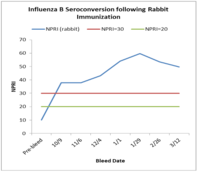Influenza B Nucleoprotein (NP) Antibody Inhibition ELISA
 Influenza viruses can be divided into three classes, A, B, and C, largely based upon conserved antigenic differences in the internal nucleoprotein. Influenza A virus, typically encountered more frequently than types B and C, and associated with the majority of serious epidemics, can be further subdivided into strains or subtypes based on antigenic differences in the external hemagglutinin proteins (H1-H18) and neuraminidase proteins (N1-N11).
Influenza viruses can be divided into three classes, A, B, and C, largely based upon conserved antigenic differences in the internal nucleoprotein. Influenza A virus, typically encountered more frequently than types B and C, and associated with the majority of serious epidemics, can be further subdivided into strains or subtypes based on antigenic differences in the external hemagglutinin proteins (H1-H18) and neuraminidase proteins (N1-N11).
Historically, human influenza A virus infections have been associated with H1N1, N2N2, and H3N2 subtypes of influenza A, although a 1997 outbreak in Hong Kong was identified as an H5N1 subtype. This outbreak was not only significant because it resulted in multiple human infections and deaths, but it also represented the first known demonstration of avian influenza virus transmission to humans.
While influenza A virus will infect a wide variety of species, influenza B virus is predominantly a human pathogen, although it has been found to infect seals. The limited host range of influenza B and a slower rate of mutation than influenza A appears to preclude development of influenza B pandemics, but influenza B is a significant human pathogen and on an individual basis, infection may result in death.
Virusys has developed a highly sensitive and specific enzyme-linked immunosorbent assay (ELISA) for the detection of influenza B nucleoprotein-specific antibodies in serum which may be used for the detection of influenza B NP antibodies in human serum as well as experimental animals.
















